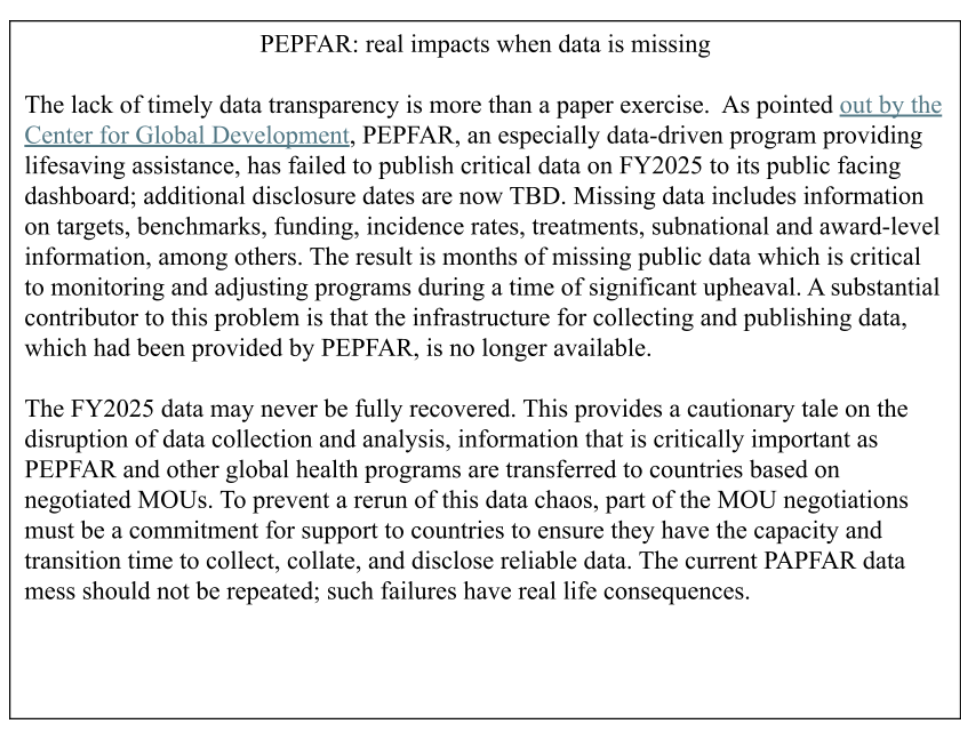Is the United States prepared to respond to the international assistance needs of today and tomorrow? This is the first in MFAN's new blog series entitled, “Moving Us Closer to Operational Readiness: Critical Needs for U.S. Foreign Assistance." This series draws on the expertise of MFAN's members to explore the specific core functions needed at the State Department to manage effective development and foreign assistance programs based on MFAN's recent report.
By George Ingram, Senior Fellow, the Brookings Institution, and Sally Paxton, U.S. Representative, Publish What You Fund.
As mandated by Congress, transparency is a cornerstone of US foreign assistance – and for good reason. Among others, it provides Congress, stakeholders, implementers, taxpayers, the executive branch, other donors, and development partners easy access to public websites and data sets to understand, improve, and hold to account U.S. foreign assistance programs. The Modernizing Foreign Assistance Network (MFAN)’s recent paper on the Department of State’s readiness to manage U.S. foreign assistance programs identified transparency as a critical issue that needs attention.
Removal of aid data
In January 2025, President Trump signed an Executive Order pausing U.S. foreign assistance programs for 90 days with the stated goal of reviewing all programs for efficiencies and consistency with U.S. foreign policy. Almost simultaneously, the Trump Administration dismantled the main USAID website, taking down enormous amounts of data and information which had the added effect of further compromising other data sets.
On February 21, 2025, we assessed the data loss in terms of funding, evaluations, program documents, and other critical information that should have been essential for the review of U.S. foreign aid programs. In April 2025, we submitted testimony outlining the critical loss of data, despite specific statutes that require timely, detailed reporting of U.S. foreign assistance. And we made specific recommendations for restoring the data so that all stakeholders would have ready access to timely and robust information.
Status of significant aid data sites
Eight months later, we are revisiting the state of publication and disclosure of this information. What follows is an assessment of the state of play of these various information sources:
Restoring data is only an initial first step to achieve sustainable data
The restoration of data and other critical information is only part of what needs to be addressed. As MFAN recently found “the State Department lacks operational readiness to effectively and accountably manage America’s foreign assistance portfolio.” It is not enough to simply transfer some of the functions from USAID to State; the State Department doesn’t have the staff, skills, and systems to effectively manage and implement the U.S. foreign assistance portfolio.
For State to meet the requirements of FATAA and to fulfill its pledge to U.S. taxpayers and assure accountability, it will need the capacity to deliver on transparency functions, especially those that were previously fulfilled by USAID. This includes not only collation and accurate reporting of timely data, and publication of evaluations, research, and learning, but also meeting other obligations such as reporting to the Organization for Economic Cooperation and Development’s foreign aid reporting dashboard (the Creditor Reporting System), legally required congressional reporting (known as “the Greenbook”), and publication to IATI. And finally, there is a strong need for State leadership to provide the vision, strategic planning, and coordination to support these functions.

Data Transparency is the Law
All these functions – including collecting and accurate reporting of timely data along with reestablishing robust monitoring and evaluation systems – are critical to an effective delivery of scarce U.S. resources. The taking down of so much U.S. data, in an apparent violation of the Federal Records Act and other laws, has dealt a significant blow to informed and efficient implementation of U.S. foreign assistance. This data is critical to informed decision making by U.S. government officials, other donors, recipient governments, and local organization and community partners. If the Administration and Congress are serious about its approach to delivering U.S. foreign assistance programs, it needs to take the Congressionally mandated transparency requirements seriously.